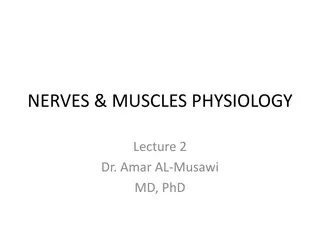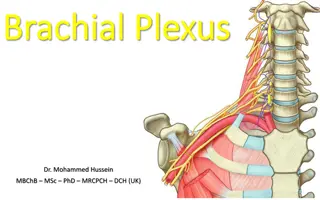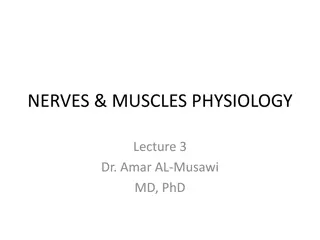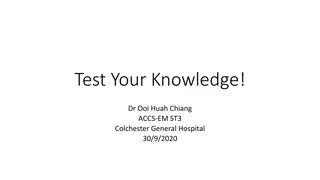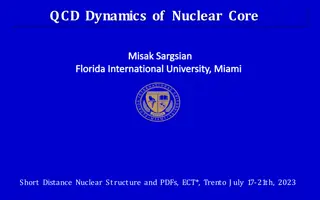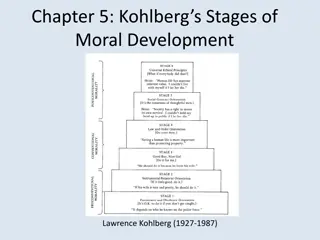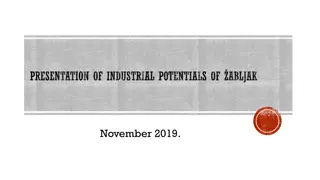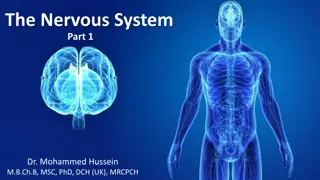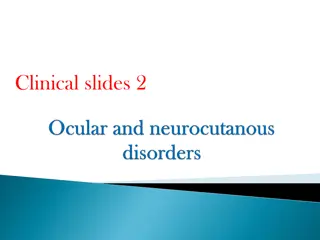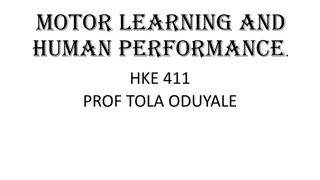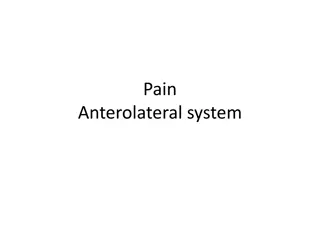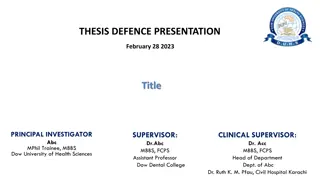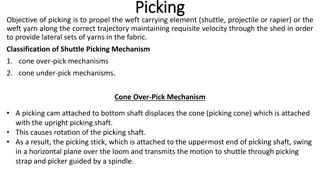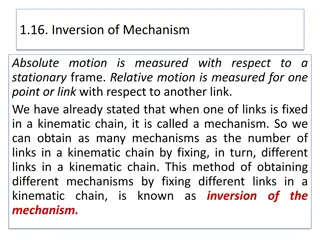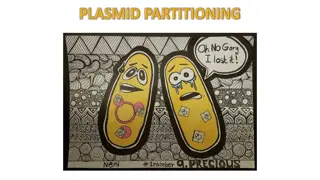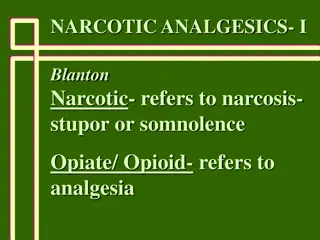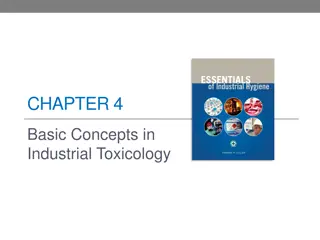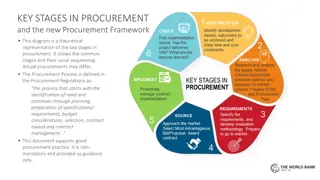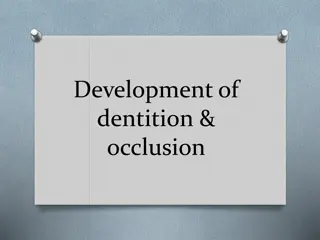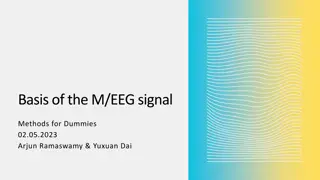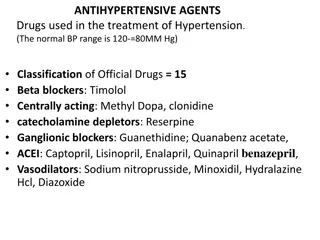Understanding Nerve Action Potentials: Key Stages and Mechanisms
Explore the intricate process of nerve action potentials, including depolarization, overshoot variations, repolarization stages, and the role of ion levels. Delve into the details of how neurons generate and propagate electrical signals essential for communication in the nervous system.
Download Presentation

Please find below an Image/Link to download the presentation.
The content on the website is provided AS IS for your information and personal use only. It may not be sold, licensed, or shared on other websites without obtaining consent from the author. Download presentation by click this link. If you encounter any issues during the download, it is possible that the publisher has removed the file from their server.
E N D
Presentation Transcript
1 Nerve Action Potential :2 Dr.Viral I. Champaneri, MD Assistant Professor Department of Physiology
2 Learning Objectives Stages of Action Potential 4. Repolarization 5. Positive afterpotential 6. After hyperpolarization Resting membrane potential of neuron Effect of Increase / Decrease level of Na+ Effect of Increase / Decrease level of K+ Role of other Ions
3 2. Depolarization Overshoot In Large nerve fibers, Overshoot Membrane potential Beyond zero level Becomes Somewhat positive
4 2. Depolarization Overshoot Smaller fibers and Many Central nervous system (CNS) neurons The potential merely approaches the zero level Does not overshoot to the positive level
5 2. Depolarization Overshoot During overshoot Direction of electrical gradient For Na+ is reversed
6 2. Depolarization Overshoot Because Membrane potential is reversed Limits Na+ influx Voltage gated K+ channels Open
7 Rising membrane potential Within Fraction of a millisecond Causes
8 Rising membrane potential Beginning of Closure of Sodium channels Opening of Potassium channel Action potential terminates
9 3. Repolarization stage of action potential Within few 10,000ths of a second Na+ channels begin to close After membrane becomes Highly permeable to K+ ions
10 3. Repolarization stage of action potential
11 3. Repolarization stage of action potential The K+ channels open More than normally Rapid diffusion of K+ ions to the exterior (Higher Concentration to Lower Concentration)
12 3. Repolarization stage of action potential Re-established The normal negative resting membrane potential (RMP: -90 mV ) called Repolarization
13 3. Repolarization stage of action potential Opening of the voltage-gated K+ channels Slower & more prolonged Than Opening of the Na+ channels
14 3. Repolarization stage of action potential Increase in K+ conductance Comes after The increase in Na+ conductance
15 Conductance of Na+ ion channels
16 Conductance of the K+ channels Where as the potassium channels Only open (Activate) And the rate of opening is much Slower than for sodium channel (Prolonged)
17 Voltage-Gated Potassium Channel During the Resting stage: The Gate of the potassium channel is Closed
18 Voltage-Gated Potassium Channel Potassium ions are Prevented from passing through this channel To the exterior
19 Voltage-Gated Potassium Channel When membrane potential rises From -90mV Towards Zero Voltage change Cause slow conformational opening of the gate Allows increased potassium diffusion outward
20 Slowness of the K+ Channels K+ channels open Just at the same time Na+ channels Beginning to close Due to Inactivation
21 3. Repolarization stage of action potential The net movement of positively charge Out of the cell Due to K+ efflux Completes The process of repolarization
22 Stages of Nerve Action Potential Resting stage Depolarization stage and Overshoot Repolarization stage After-hyperpolarization
23 4. Positive After potential Membrane potential becomes more negative Than Original RMP (- 90 mV) For few milliseconds After action potential Over
24 4. Positive After potential Positive after potential is Misnomer Because positive afterpotential Is even more negative Than resting membrane potential (RMP =-90mV)
25 4. Positive After potential Reason for calling it Positive Historically The first potential measurement Were made on The outside of the nerve fiber membrane Was Positive
26 4. Positive After potential Than The inside When measured on the outside This potential causes a positive record Rather than a negative one
27 4. Positive After potential Cause of the positive afterpotential Mainly Many potassium channels Remain open for several milliseconds After complete repolarization of the membrane
28 -65 -90
29 4. After-hyperpolarization The slow return of the K+ channels To the closed state explain After-hyperpolarization F/b return To the resting membrane potential
30 5. End of action potential Voltage-gated K+ channels Bring the action potential To the end Cause closer of their gates through Negative feedback process
31 Negative feedback loop during Repolarization
32 Resting Membrane Potential in Neurons About -70mV Close to the equilibrium potential for K+ Because there are more open K+ channels Than Na+ channels at rest Membrane permeability to K+ is greater at rest
33 Resting Membrane Potential in neurons Intracellular and extracellular Concentration of K+ Prime determinant of the RMP (Nernst potential) Therefore RMP is close to equilibrium potential of K+
34 Decrease ECF level of Na+ AP Decrease ECF [Na+] Hyponatraemia The external level of Na+ concentration Reduce the size of action potential
35 Depolarization stage of action potential
36 Decrease ECF level of Na+ RMP Hyponatraemia Little effect on the RMP Because Permeability of the membrane to Na+ at rest is relatively low
37 Decrease / Increase ECF level K+ Resting membrane potential Is close to equilibrium potential for K+ Change in external concentration of K+ ions Major effects on the RMP
38 Increase ECF level K+ Hyperkalemia ECF level of K+ is increased Hyperkalemia The RMP ( of Neuron : -70 mV) moves closer To the threshold for eliciting an action potential Neuron becomes More excitable
39 Decrease ECF level K+ Hypokalemia ECF level of K+ is Decreased Hypokalemia RMP (-70mV) Reduced Neuron Hyperpolarized
40 Role of other Ions During the Action Potential 1. Impermeant Negatively Charged Ions (Anions) inside the Axon 2. Calcium Ions
41 Impermeant Anions inside the axon Inside the axon Many negatively charged ions (Anions) That can not go through the membrane channels
42 Impermeant Anions inside the axon Includes Anions of the Protein molecules Anions of many Organic phosphate compounds Anions of Sulfate compounds
43 Impermeant Anions inside the axon Because these ions Cannot leave the interior of the axon
44 Impermeant Anions inside the axon Excess of these impermeant anions Deficit of positive ions inside the membrane
45 Impermeant Anions inside the axon Responsible For the negative charge inside the fiber When there is deficit of positive charged K+ And other positive ions
46 Calcium Ions Membranes of almost all cells of the body Have Ca2+ pump Similar to Na+ pump
47 Calcium ions serves Along with or Instead of Na+ In some cells To cause most of action potential
48 Calcium pump Like Sodium (Na+) pump Pumps Ca2+ ions
49 Calcium pump Ca2+ From the interior To the exterior of the cell membrane Or To endoplasmic reticulum (ER)
50 Calcium ions gradient Of 10,000 folds due to it Internal cell concentration of calcium ions of 10-7 molar External concentration of 10-3 molar



